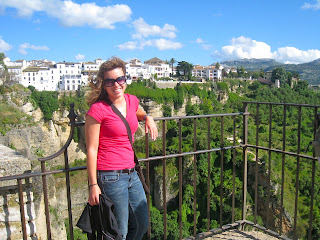While there are many things I am going to miss about Spain there are some things I cannot wait for back in the U.S. First of all, I cannot wait for public bathrooms that I know will have toilet paper, soap, and a means to dry your hands. Secondly, I know I was extremely lucky with my host mom’s cooking (it was delicious!) but I am definitely looking forward to vegetables not bathed in olive oil and a source of carbohydrates other than white bread. The people from Sevilla will not be missed either. Unfortunately based on my experiences with the citizens of capital of Andalucía were not favorable, they were usually rude, pushy, never got out of the way, and never apologized for anything. This was the complete opposite of everyone I met in Sevilla but were from a small town and had moved into the city. All of these “country folk” (including my host mom, intercambio, etc.) were so kind and friendly, a complete 180 from the natives of Sevilla.
At first I was disappointed not to be making as many Spanish friends as I had hoped, but I would never give up the friendships I made with the people in my program. I have met so many wonderful individuals that I will never forget and I know we all plan on continuing these relationships we’ve made. It is crazy to think how sixty people can be thrown together in a foreign country and immediately become best friends and all of our experiences have made us that much closer.
One of our last nights in Sevilla our program hosted a goodbye dinner where many tears were shed and memories shared. I had bought a flag with the Sevilla “logo” on it and had everyone sign it. The ‘NO8DO’ printed on the flag can be found all over Sevilla and the 8 is supposed to be a spool of wool (madeja in Spanish) and when said quickly it sounds like no me ha dejado, in English: you have not left me. This was a saying given to Sevilla by a king whose son attempted to overthrow his father, but Sevilla remained faithful to their king. Now for us it has another meaning, that what we have experienced with each other in Sevilla will last a lifetime and never leave us no matter where we go.

















































